Abstract
Previously, from the plasma of unrelated haemophilia-B patients, we isolated two non-functional Factor IX variants, namely Los Angeles (IXLA) and Long Beach (IXLB). Both variants could be cleaved to yield Factor IXa-like molecules, but were defective in catalysing the cleavage of Factor X (macromolecular substrate) and in binding to antithrombin III (macromolecular inhibitor). In the present study we have identified the mutation of IXLA by amplifying the exons (including flanking regions) as well as the 5' end of the gene by polymerase-chain-reaction (PCR) method and sequencing the amplified DNA by the dideoxy chain-termination method. Comparison of the normal IX and IXLA sequences revealed only one base substitution (T----C) in exon VIII of IXLA, with a predicted replacement of Ile-397 to Thr in the mature protein. This mutation is the same as found recently for IXLB. The observation that IXLB and IXLA have the same mutation is an unexpected finding, since, on the basis of their ox brain prothrombin time (PT, a test that measures the ability of the variant Factor IX molecules to inhibit the activation of Factor X by Factor VIIa-tissue factor complex), these variants have been classified into two different groups and were thought to be genetically different. Our observation thus suggests that the ox brain PT does not reflect the locus of mutation in the coding region of the variant molecules. However, our analysis suggests that the ox brain PT is related to Factor IX antigen concentration in the patient's plasma. Importantly, although the mutation in IXLA or IXLB protein is in the catalytic domain, purified IXaLA and IXaLB hydrolyse L-tosylarginine methyl ester at rates very similar to that of normal IXa. These data, in conjunction with our recent data on Factor IXBm Lake Elsinore (Ala-390----Val mutant), strengthen a conclusion that the peptide region containing residues 390-397 of normal Factor IXa plays an essential role in macromolecular substrate catalysis and inhibitor binding. However, the two mutations noted thus far in this region do not distort S1 binding site in the Factor IXa enzyme.
Full text
PDF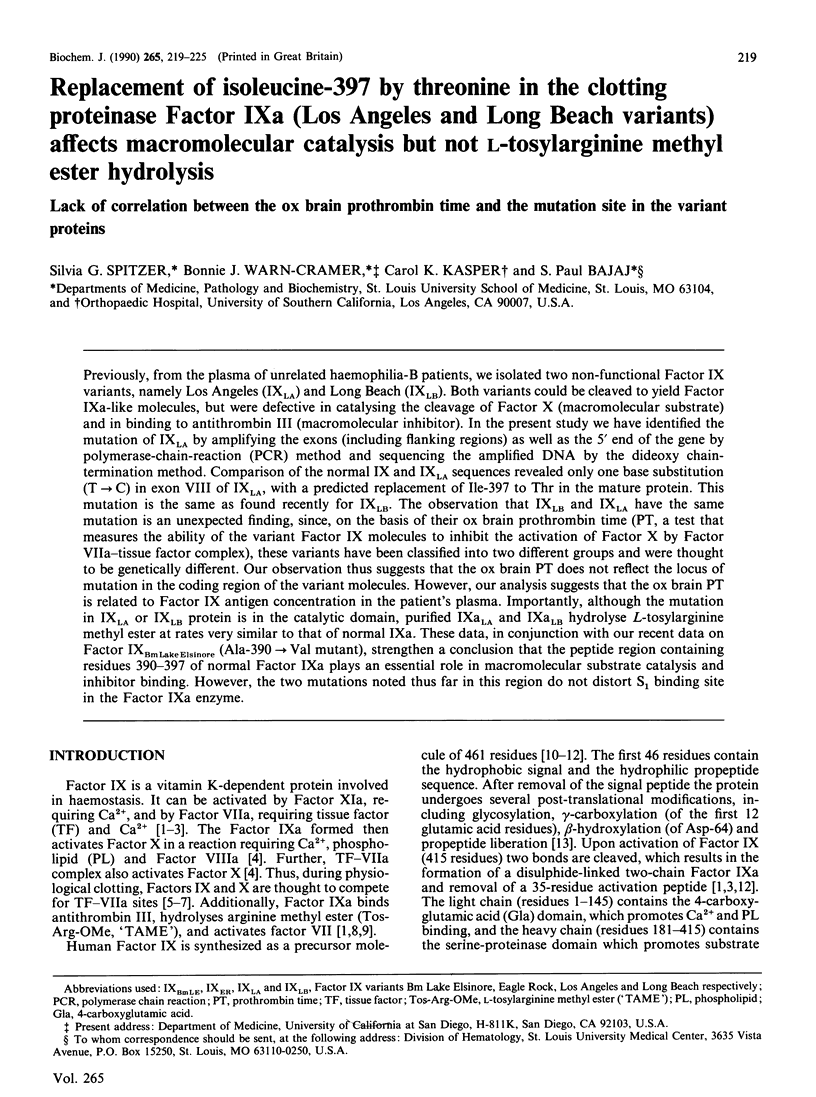
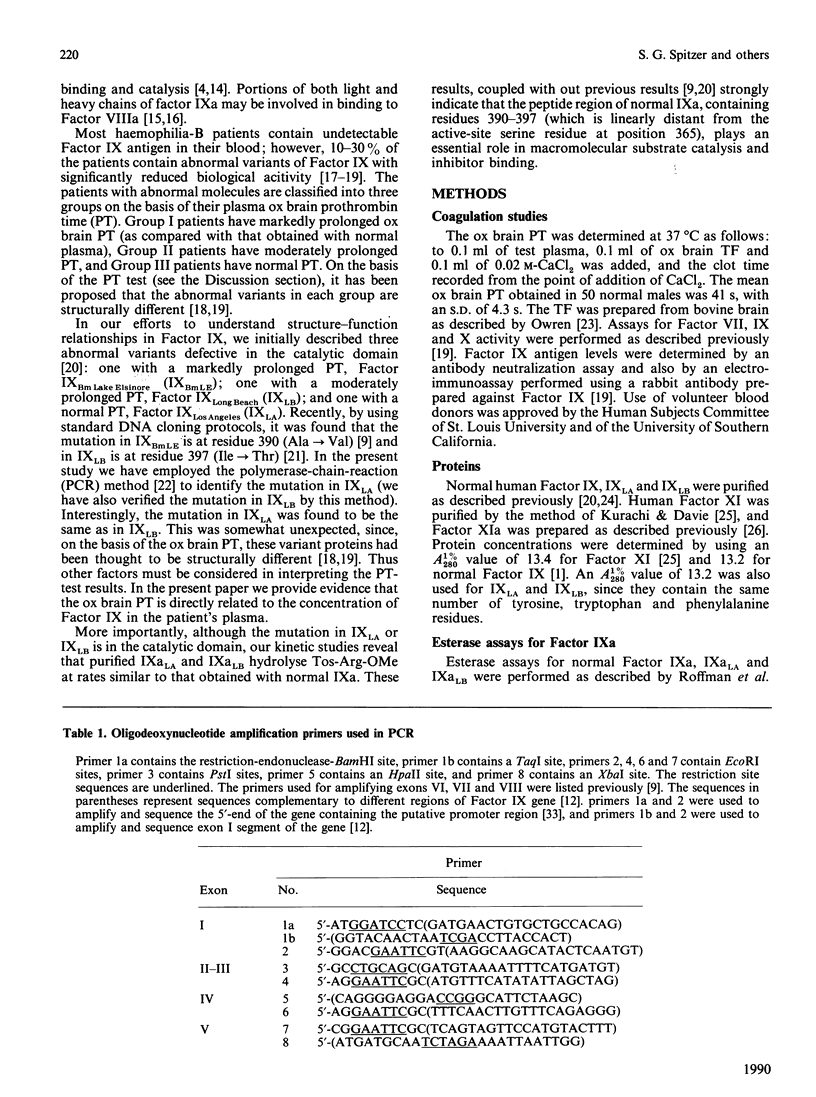
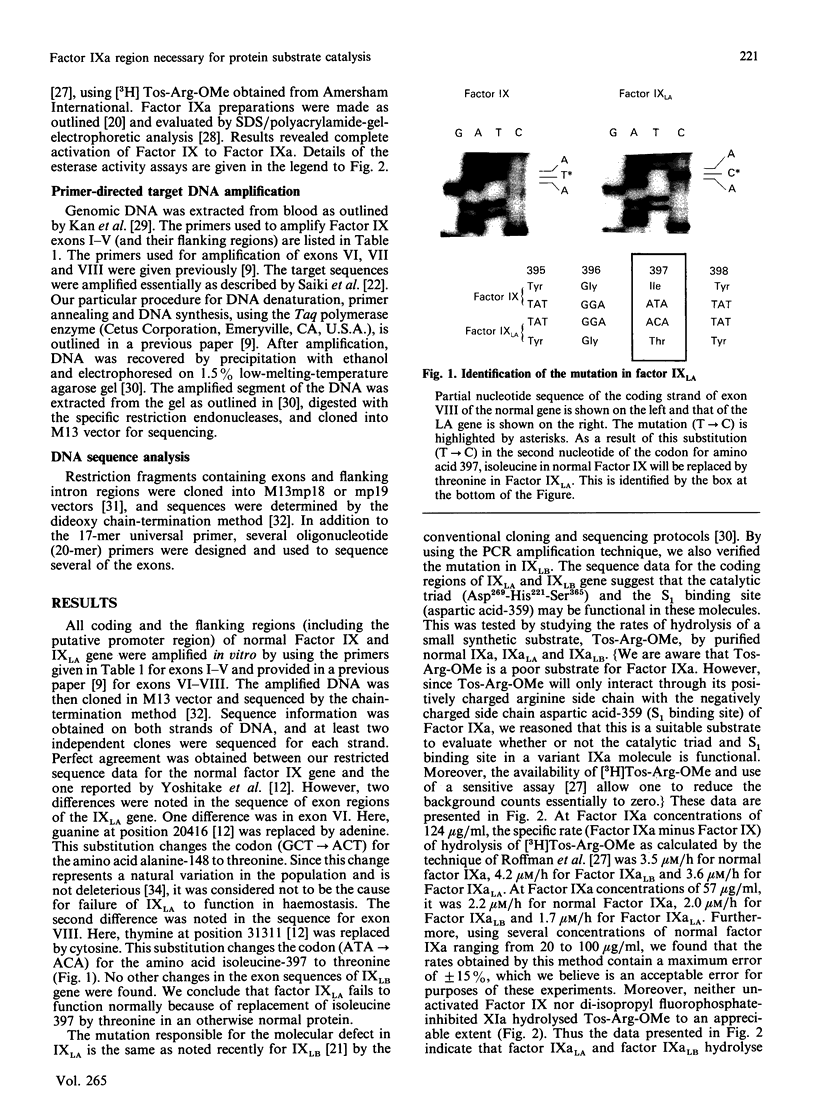
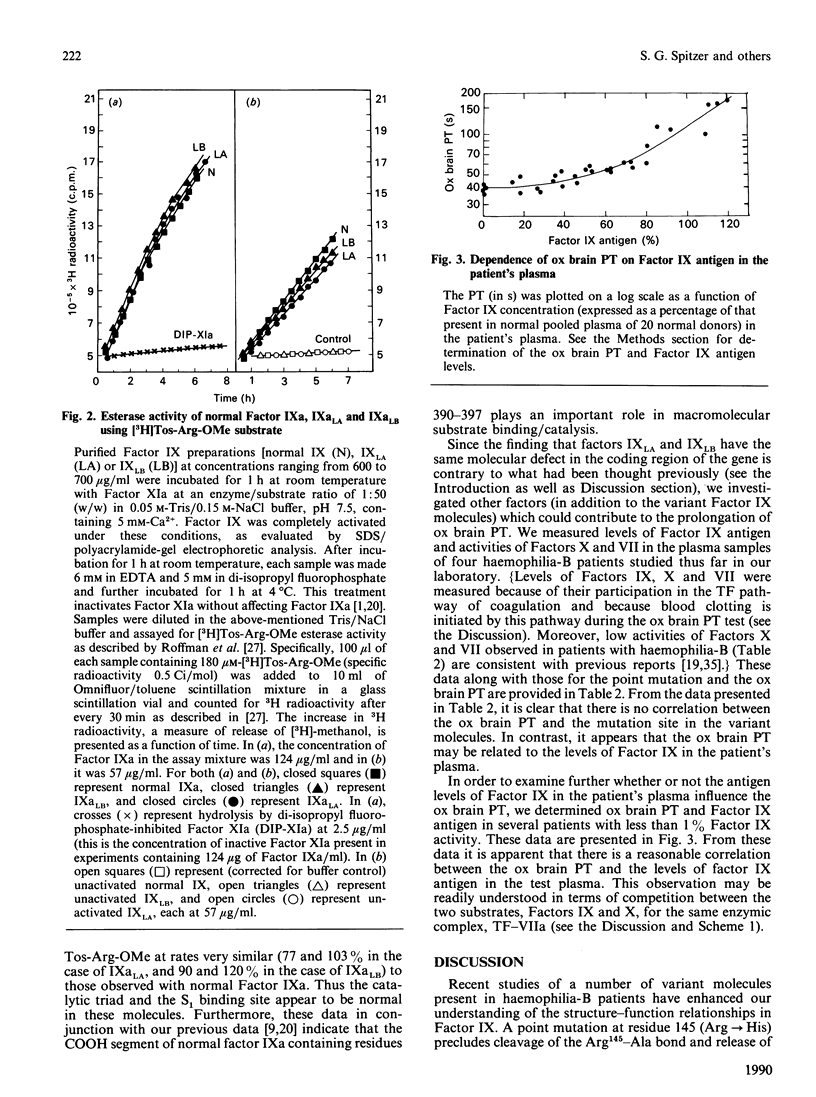
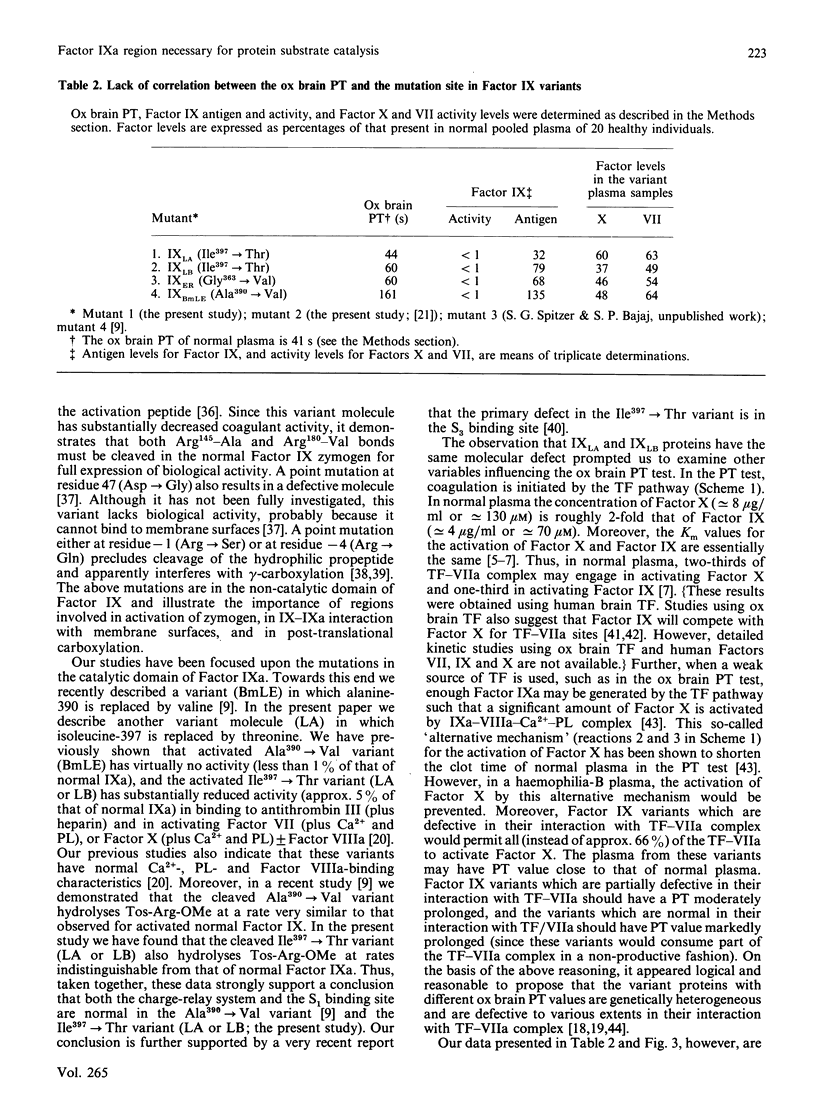

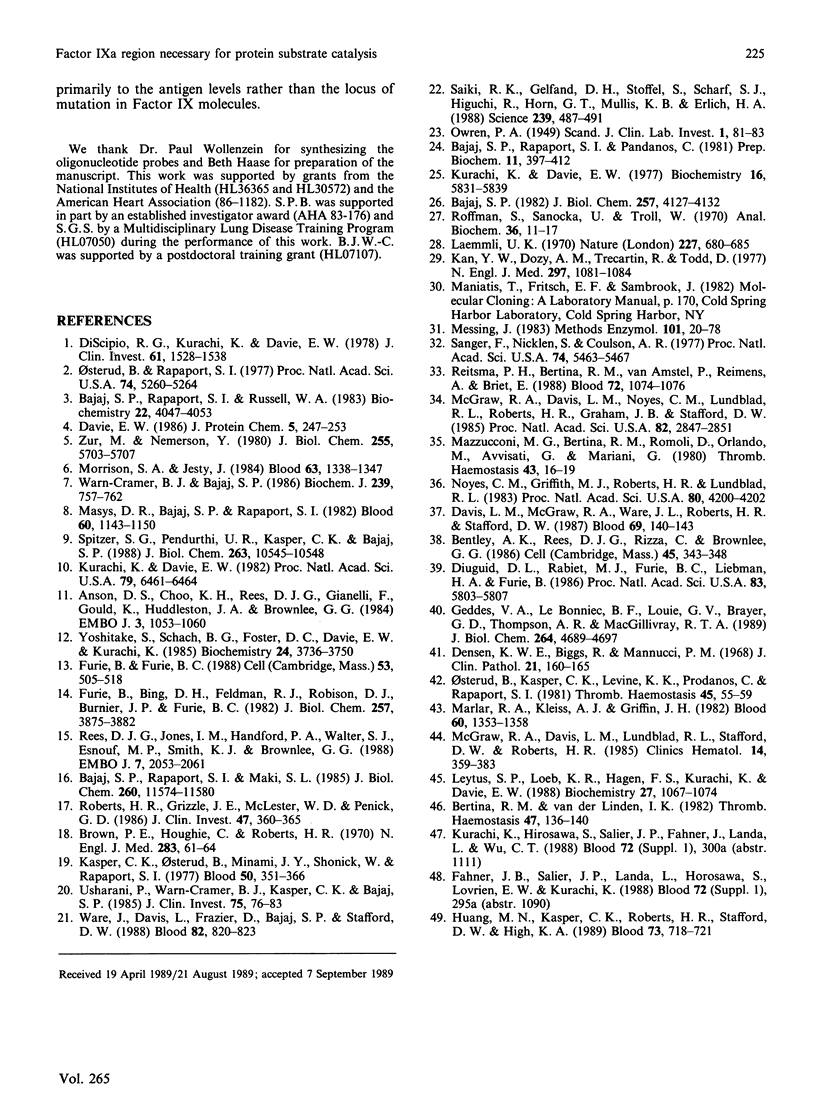
Images in this article
Selected References
These references are in PubMed. This may not be the complete list of references from this article.
- Anson D. S., Choo K. H., Rees D. J., Giannelli F., Gould K., Huddleston J. A., Brownlee G. G. The gene structure of human anti-haemophilic factor IX. EMBO J. 1984 May;3(5):1053–1060. doi: 10.1002/j.1460-2075.1984.tb01926.x. [DOI] [PMC free article] [PubMed] [Google Scholar]
- Bajaj S. P. Cooperative Ca2+ binding to human factor IX. Effects of Ca2+ on the kinetic parameters of the activation of factor IX by factor XIa. J Biol Chem. 1982 Apr 25;257(8):4127–4132. [PubMed] [Google Scholar]
- Bajaj S. P., Rapaport S. I., Maki S. L. A monoclonal antibody to factor IX that inhibits the factor VIII:Ca potentiation of factor X activation. J Biol Chem. 1985 Sep 25;260(21):11574–11580. [PubMed] [Google Scholar]
- Bajaj S. P., Rapaport S. I., Prodanos C. A simplified procedure for purification of human prothrombin, factor IX and factor X. Prep Biochem. 1981;11(4):397–412. doi: 10.1080/00327488108065531. [DOI] [PubMed] [Google Scholar]
- Bajaj S. P., Rapaport S. I., Russell W. A. Redetermination of the rate-limiting step in the activation of factor IX by factor XIa and by factor VIIa/tissue factor. Explanation for different electrophoretic radioactivity profiles obtained on activation of 3H- and 125I-labeled factor IX. Biochemistry. 1983 Aug 16;22(17):4047–4053. doi: 10.1021/bi00286a009. [DOI] [PubMed] [Google Scholar]
- Bentley A. K., Rees D. J., Rizza C., Brownlee G. G. Defective propeptide processing of blood clotting factor IX caused by mutation of arginine to glutamine at position -4. Cell. 1986 May 9;45(3):343–348. doi: 10.1016/0092-8674(86)90319-3. [DOI] [PubMed] [Google Scholar]
- Bertina R. M., van der Linden I. K. Factor IX Deventer-evidence for the heterogeneity of hemophilia BM. Thromb Haemost. 1982 Apr 30;47(2):136–140. [PubMed] [Google Scholar]
- Brown P. E., Hougie C., Roberts H. R. The genetic heterogeneity of hemophilia B. N Engl J Med. 1970 Jul 9;283(2):61–64. doi: 10.1056/NEJM197007092830203. [DOI] [PubMed] [Google Scholar]
- Davis L. M., McGraw R. A., Ware J. L., Roberts H. R., Stafford D. W. Factor IXAlabama: a point mutation in a clotting protein results in hemophilia B. Blood. 1987 Jan;69(1):140–143. [PubMed] [Google Scholar]
- Denson K. W., Biggs R., Mannucci P. M. An investigation of three patients with Christmas disease due to an abnormal type of factor IX. J Clin Pathol. 1968 Mar;21(2):160–165. doi: 10.1136/jcp.21.2.160. [DOI] [PMC free article] [PubMed] [Google Scholar]
- Di Scipio R. G., Kurachi K., Davie E. W. Activation of human factor IX (Christmas factor). J Clin Invest. 1978 Jun;61(6):1528–1538. doi: 10.1172/JCI109073. [DOI] [PMC free article] [PubMed] [Google Scholar]
- Diuguid D. L., Rabiet M. J., Furie B. C., Liebman H. A., Furie B. Molecular basis of hemophilia B: a defective enzyme due to an unprocessed propeptide is caused by a point mutation in the factor IX precursor. Proc Natl Acad Sci U S A. 1986 Aug;83(16):5803–5807. doi: 10.1073/pnas.83.16.5803. [DOI] [PMC free article] [PubMed] [Google Scholar]
- Furie B., Bing D. H., Feldmann R. J., Robison D. J., Burnier J. P., Furie B. C. Computer-generated models of blood coagulation factor Xa, factor IXa, and thrombin based upon structural homology with other serine proteases. J Biol Chem. 1982 Apr 10;257(7):3875–3882. [PubMed] [Google Scholar]
- Furie B., Furie B. C. The molecular basis of blood coagulation. Cell. 1988 May 20;53(4):505–518. doi: 10.1016/0092-8674(88)90567-3. [DOI] [PubMed] [Google Scholar]
- Geddes V. A., Le Bonniec B. F., Louie G. V., Brayer G. D., Thompson A. R., MacGillivray R. T. A moderate form of hemophilia B is caused by a novel mutation in the protease domain of factor IXVancouver. J Biol Chem. 1989 Mar 15;264(8):4689–4697. [PubMed] [Google Scholar]
- Huang M. N., Kasper C. K., Roberts H. R., Stafford D. W., High K. A. Molecular defect in factor IXHilo, a hemophilia Bm variant: Arg----Gln at the carboxyterminal cleavage site of the activation peptide. Blood. 1989 Feb 15;73(3):718–721. [PubMed] [Google Scholar]
- Kan Y. W., Dozy A. M., Trecartin R., Todd D. Identification of a nondeletion defect in alpha-thalassemia. N Engl J Med. 1977 Nov 17;297(20):1081–1084. doi: 10.1056/NEJM197711172972002. [DOI] [PubMed] [Google Scholar]
- Kasper C. K., Osterud B., Minami J. Y., Shonick W., Rapaport S. I. Hemophilia B: characterization of genetic variants and detection of carriers. Blood. 1977 Sep;50(3):351–366. [PubMed] [Google Scholar]
- Kurachi K., Davie E. W. Activation of human factor XI (plasma thromboplastin antecedent) by factor XIIa (activated Hageman factor). Biochemistry. 1977 Dec 27;16(26):5831–5839. doi: 10.1021/bi00645a030. [DOI] [PubMed] [Google Scholar]
- Kurachi K., Davie E. W. Isolation and characterization of a cDNA coding for human factor IX. Proc Natl Acad Sci U S A. 1982 Nov;79(21):6461–6464. doi: 10.1073/pnas.79.21.6461. [DOI] [PMC free article] [PubMed] [Google Scholar]
- Laemmli U. K. Cleavage of structural proteins during the assembly of the head of bacteriophage T4. Nature. 1970 Aug 15;227(5259):680–685. doi: 10.1038/227680a0. [DOI] [PubMed] [Google Scholar]
- Leytus S. P., Loeb K. R., Hagen F. S., Kurachi K., Davie E. W. A novel trypsin-like serine protease (hepsin) with a putative transmembrane domain expressed by human liver and hepatoma cells. Biochemistry. 1988 Feb 9;27(3):1067–1074. doi: 10.1021/bi00403a032. [DOI] [PubMed] [Google Scholar]
- Marlar R. A., Kleiss A. J., Griffin J. H. An alternative extrinsic pathway of human blood coagulation. Blood. 1982 Dec;60(6):1353–1358. [PubMed] [Google Scholar]
- Masys D. R., Bajaj S. P., Rapaport S. I. Activation of human factor VII by activated factors IX and X. Blood. 1982 Nov;60(5):1143–1150. [PubMed] [Google Scholar]
- Mazzucconi M. G., Bertina R. M., Romoli D., Orlando M., Avvisati G., Mariani G. Factor VII activity and antigen in haemophilia B variants. Thromb Haemost. 1980 Feb 29;43(1):16–19. [PubMed] [Google Scholar]
- McGraw R. A., Davis L. M., Lundblad R. L., Stafford D. W., Roberts H. R. Structure and function of factor IX: defects in haemophilia B. Clin Haematol. 1985 Jun;14(2):359–383. [PubMed] [Google Scholar]
- McGraw R. A., Davis L. M., Noyes C. M., Lundblad R. L., Roberts H. R., Graham J. B., Stafford D. W. Evidence for a prevalent dimorphism in the activation peptide of human coagulation factor IX. Proc Natl Acad Sci U S A. 1985 May;82(9):2847–2851. doi: 10.1073/pnas.82.9.2847. [DOI] [PMC free article] [PubMed] [Google Scholar]
- Messing J. New M13 vectors for cloning. Methods Enzymol. 1983;101:20–78. doi: 10.1016/0076-6879(83)01005-8. [DOI] [PubMed] [Google Scholar]
- Morrison S. A., Jesty J. Tissue factor-dependent activation of tritium-labeled factor IX and factor X in human plasma. Blood. 1984 Jun;63(6):1338–1347. [PubMed] [Google Scholar]
- Noyes C. M., Griffith M. J., Roberts H. R., Lundblad R. L. Identification of the molecular defect in factor IX Chapel Hill: substitution of histidine for arginine at position 145. Proc Natl Acad Sci U S A. 1983 Jul;80(14):4200–4202. doi: 10.1073/pnas.80.14.4200. [DOI] [PMC free article] [PubMed] [Google Scholar]
- Osterud B., Kasper C. K., Lavine K. K., Prodanos C., Rapaport S. I. Purification and properties of an abnormal blood coagulation factor IX (factor IXBm)/kinetics of its inhibition of factor X activation by factor VII and bovine tissue factor. Thromb Haemost. 1981 Feb 23;45(1):55–59. [PubMed] [Google Scholar]
- Osterud B., Rapaport S. I. Activation of factor IX by the reaction product of tissue factor and factor VII: additional pathway for initiating blood coagulation. Proc Natl Acad Sci U S A. 1977 Dec;74(12):5260–5264. doi: 10.1073/pnas.74.12.5260. [DOI] [PMC free article] [PubMed] [Google Scholar]
- Rees D. J., Jones I. M., Handford P. A., Walter S. J., Esnouf M. P., Smith K. J., Brownlee G. G. The role of beta-hydroxyaspartate and adjacent carboxylate residues in the first EGF domain of human factor IX. EMBO J. 1988 Jul;7(7):2053–2061. doi: 10.1002/j.1460-2075.1988.tb03045.x. [DOI] [PMC free article] [PubMed] [Google Scholar]
- Reitsma P. H., Bertina R. M., Ploos van Amstel J. K., Riemens A., Briët E. The putative factor IX gene promoter in hemophilia B Leyden. Blood. 1988 Sep;72(3):1074–1076. [PubMed] [Google Scholar]
- Roberts H. R., Grizzle J. E., McLester W. D., Penick G. D. Genetic variants of hemophilia B: detection by means of a specific PTC inhibitor. J Clin Invest. 1968 Feb;47(2):360–365. doi: 10.1172/JCI105732. [DOI] [PMC free article] [PubMed] [Google Scholar]
- Roffman S., Sanocka U., Troll W. Sensitive proteolytic enzyme assay using differential solubilities of radioactive substrates and products in biphasic systems. Anal Biochem. 1970 Jul;36(1):11–17. doi: 10.1016/0003-2697(70)90326-x. [DOI] [PubMed] [Google Scholar]
- Saiki R. K., Gelfand D. H., Stoffel S., Scharf S. J., Higuchi R., Horn G. T., Mullis K. B., Erlich H. A. Primer-directed enzymatic amplification of DNA with a thermostable DNA polymerase. Science. 1988 Jan 29;239(4839):487–491. doi: 10.1126/science.2448875. [DOI] [PubMed] [Google Scholar]
- Sanger F., Nicklen S., Coulson A. R. DNA sequencing with chain-terminating inhibitors. Proc Natl Acad Sci U S A. 1977 Dec;74(12):5463–5467. doi: 10.1073/pnas.74.12.5463. [DOI] [PMC free article] [PubMed] [Google Scholar]
- Spitzer S. G., Pendurthi U. R., Kasper C. K., Bajaj S. P. Molecular defect in factor IXBm Lake Elsinore. Substitution of Ala390 by Val in the catalytic domain. J Biol Chem. 1988 Aug 5;263(22):10545–10548. [PubMed] [Google Scholar]
- Usharani P., Warn-Cramer B. J., Kasper C. K., Bajaj S. P. Characterization of three abnormal factor IX variants (Bm Lake Elsinore, Long Beach, and Los Angeles) of hemophilia-B. Evidence for defects affecting the latent catalytic site. J Clin Invest. 1985 Jan;75(1):76–83. doi: 10.1172/JCI111700. [DOI] [PMC free article] [PubMed] [Google Scholar]
- Ware J., Davis L., Frazier D., Bajaj S. P., Stafford D. W. Genetic defect responsible for the dysfunctional protein: factor IXLong Beach. Blood. 1988 Aug;72(2):820–822. [PubMed] [Google Scholar]
- Warn-Cramer B. J., Bajaj S. P. Intrinsic versus extrinsic coagulation. Kinetic considerations. Biochem J. 1986 Nov 1;239(3):757–762. doi: 10.1042/bj2390757. [DOI] [PMC free article] [PubMed] [Google Scholar]
- Yoshitake S., Schach B. G., Foster D. C., Davie E. W., Kurachi K. Nucleotide sequence of the gene for human factor IX (antihemophilic factor B). Biochemistry. 1985 Jul 2;24(14):3736–3750. doi: 10.1021/bi00335a049. [DOI] [PubMed] [Google Scholar]
- Zur M., Nemerson Y. Kinetics of factor IX activation via the extrinsic pathway. Dependence of Km on tissue factor. J Biol Chem. 1980 Jun 25;255(12):5703–5707. [PubMed] [Google Scholar]



